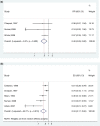'Kangaroo mother care' to prevent neonatal deaths due to preterm birth complications
- PMID: 20348117
- PMCID: PMC2845870
- DOI: 10.1093/ije/dyq031
'Kangaroo mother care' to prevent neonatal deaths due to preterm birth complications
Abstract
Background: 'Kangaroo mother care' (KMC) includes thermal care through continuous skin-to-skin contact, support for exclusive breastfeeding or other appropriate feeding, and early recognition/response to illness. Whilst increasingly accepted in both high- and low-income countries, a Cochrane review (2003) did not find evidence of KMC's mortality benefit, and did not report neonatal-specific data.
Objectives: The objectives of this study were to review the evidence, and estimate the effect of KMC on neonatal mortality due to complications of preterm birth.
Methods: We conducted systematic reviews. Standardized abstraction tables were used and study quality assessed by adapted GRADE methodology. Meta-analyses were undertaken.
Results: We identified 15 studies reporting mortality and/or morbidity outcomes including nine randomized controlled trials (RCTs) and six observational studies all from low- or middle-income settings. Except one, all were hospital-based and included only babies of birth-weight <2000 g (assumed preterm). The one community-based trial had missing birthweight data, as well as other limitations and was excluded. Neonatal-specific data were supplied by two authors. Meta-analysis of three RCTs commencing KMC in the first week of life showed a significant reduction in neonatal mortality [relative risk (RR) 0.49, 95% confidence interval (CI) 0.29-0.82] compared with standard care. A meta-analysis of three observational studies also suggested significant mortality benefit (RR 0.68, 95% CI 0.58-0.79). Five RCTs suggested significant reductions in serious morbidity for babies <2000 g (RR 0.34, 95% CI 0.17-0.65).
Conclusion: This is the first published meta-analysis showing that KMC substantially reduces neonatal mortality amongst preterm babies (birth weight <2000 g) in hospital, and is highly effective in reducing severe morbidity, particularly from infection. However, KMC remains unavailable at-scale in most low-income countries.
Figures



Comment in
-
Comment on: 'Kangaroo mother care' to prevent neonatal deaths due to pre-term birth complications.Int J Epidemiol. 2011 Apr;40(2):521-5. doi: 10.1093/ije/dyq174. Epub 2010 Nov 2. Int J Epidemiol. 2011. PMID: 21044980 No abstract available.
References
-
- Lawn JE, Cousens S, Zupan J. 4 million neonatal deaths: when? Where? Why? Lancet. 2005;365:891–900. - PubMed
-
- Lawn JE, Wilczynska-Ketende K, Cousens SN. Estimating the causes of 4 million neonatal deaths in the year 2000. Int J Epidemiol. 2006;35:706–18. - PubMed
-
- Darmstadt GL, Bhutta ZA, Cousens S, Adam T, Walker N, De Bernis L. Evidence-based, cost-effective interventions: how many newborn babies can we save? Lancet. 2005;365:977–88. - PubMed
-
- Institute of Medicine. Preterm Birth. . Causes, Consequences, and Prevention. Washington, DC: National Academies Press; 2007. - PubMed
Publication types
MeSH terms
LinkOut - more resources
Full Text Sources
Other Literature Sources
Medical

